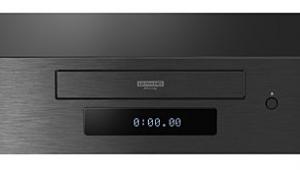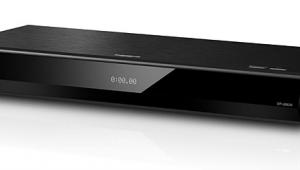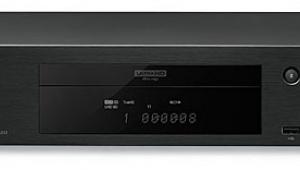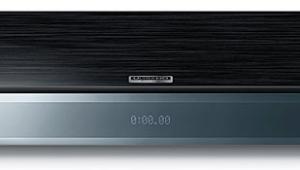Sony BDP-S5000ES Blu-ray Player
Elevating the Blu-ray Standard?
Sony’s Elevated Standard (ES) products have long been at the respected upper end of the company’s product line. I remember Sony’s early ES DVD players were the cat’s meow in terms of solid video performance and features. If you wanted reference-quality DVD playback early on in the format, you wanted an ES player. Now Sony has delivered two ES branded Blu-ray players. For this review, I’m going to look at its new flagship, the BDP-S5000ES.

Premiere Build
The BDP-S5000ES is a tank when it comes to build quality. Sony didn’t skimp a bit here. The chassis has a very upscale look and feel, with a machined front face and gold-plated reinforced connectors on the back. All of the connectors have a solid feel and aren’t the cheap stamped variety you’ll find on most budget players. The Sony features a 7.1-channel analog output plus a separate two-channel analog output. On the digital side, you’ll find TosLink and coaxial digital outputs and of course an HDMI 1.3a output. The player also includes component, composite, and S-video outputs.
The front panel has a simple, elegant look that isn’t busy. The disc tray has a solid feel and is coated for disc protection. There are small LED indicators for playback modes and large buttons on the right side for basic operations, including play, pause, and stop. My only real complaint is the operation of the tray. It opens when you press the Eject button, but it doesn’t close when you press Play. I typically place a disc on the tray and press Play to start the loading process, but this player’s tray only responds to the Eject button. It’s not a big deal, but this may be the first player I’ve ever used that did this. I found it to be a bit of an annoyance.
Since the BDP-S5000ES is BD-Live compliant, it includes a LAN connection for Internet connectivity. To meet the hardware spec’s 1-gigabyte local storage requirement, Sony includes an external memory port and a 1-GB Sony Micro Vault flash drive with the player. The memory port only works with Micro Vault drives, so if you wish to bump up your BD-Live storage capacity, you’ll need to stick with Sony. At press time, Sonystyle.com listed a 2-GB Micro Vault drive at $20 and a 4-GB drive at $30. This is far more expensive than generic USB thumb drives, and I’m hard-pressed to see how this approach benefits the user.
Elevating Our Standards
DVD video came out before progressive displays were the norm, and the format went through the growing pains of progressive-scan playback and then later upconversion. How well a player performed in these areas varied considerably from model to model. Higher-end models typically did a far better job, as they incorporated the newest video-processing chips.

That has carried over to Blu-ray. If you’ve been reading our reviews, you know there are players at $399 and below that offer excellent performance with 1080p/24 Blu-ray Discs. They also provide outstanding video processing with Blu-ray and standard DVDs, often with name-brand premium processing. With these things in mind, I think manufacturers need to start taking a closer look at the features that make up a flagship design. From what I’ve seen so far, manufacturers are delivering features that used to be considered premium in these players but may not be anymore.
In the flagship designs I’ve seen so far, one of the things that surprises me is the lack of innovation in connectivity. The BDP-S5000ES retails for $2,000. That’s nearly seven times more expensive than Sony’s standard Blu-ray players and nearly five times more than the popular PlayStation 3. At this price point, why are we not seeing features like Wi-Fi connectivity? I don’t know a lot of people who have Internet connections near their A/V racks, but I do know a lot of people with Wi-Fi. This is a standard feature on the PS3, and it’s one of my favorite features for that platform. At price points like this, I don’t think it’s too much to ask from any manufacturer.
All Your Blu-ray Bases Covered
As far as core BD player functionality goes, the BDP-S5000ES is fully loaded. It includes Bonus View PiP and BD-Live, as well as onboard decoding of all the lossless audio codecs from Dolby and DTS (to multichannel PCM or up to 7.1-channel analog). The player can also output the advanced audio codecs in bitstream form if you want to leave the decoding to your AVR or surround processor.
There’s been a lot of speculation as to the preferred method for audio decoding. Since my processor features advanced audio decoding, I put it to the test with a couple of Blu-ray Discs. When I switched between decoding in my processor and the player’s internal decoding to PCM, I didn’t notice any sonic differences in playback levels or dynamics.
However, I did find other benefits when I let the player do the decoding. The most obvious was its ability to mix the secondary audio into the soundtrack with picture-in-picture features on Bonus View capable titles. You also get to hear the menu sounds that are mixed in. Another advantage that some users may not know about pertains to Dynamic Range Control (DRC). Some discs are improperly mastered and include metadata flags that engage the DRC filters in some surround processors and AVRs. This was the case with several Paramount Blu-rays, including the recent Iron Man disc. For proper playback with a bitstream output, I had to manually turn off the DRC in my surround processor every time I played this disc. When I set up the Sony to decode to PCM, I disabled DRC during setup, and it never turned on again.
The BDP-S5000ES did a fine job with BD-Live playback. I tested it with several Sony and Universal titles and didn’t experience any glitches. You can update the player’s firmware via the LAN connection from the Setup menu or set the player to randomly poll the update Website, so it can tell you if there is a firmware update available. This is a nice touch. It’s another feature that the PS3 has boasted for some time, and I’m pleased to see that Sony has incorporated it into a standalone design.
Blu-ray/DVD Video Testing
At this point, I suspected that the BDP-S5000ES would incorporate a name-brand video-processing solution, and I was eager to test the player to confirm this. The BDP-S350 (HT, November 2008) was Sony’s first Blu-ray player to include HD deinterlacing, although it was limited to 3:2-based material. Unfortunately, the BDP-S5000ES takes a step back in this department. With our standard 1080i HD deinterlacing tests, the BDP-S5000ES didn’t pass our 3:2- or 2:2-based deinterlacing tests. This is surprising at this price point, since there are a number of lower-end players that have no problems with these tests at all. There are only a few 1080i-encoded Blu-ray Discs out there, but it’s still important for a player to offer the right video processing to maximize video performance with all discs. Considering the fact that Sony Music releases the majority of 1080i content on the Blu-ray market, it’s even more baffling that this player doesn’t offer premium-quality video processing.
The BDP-S5000ES did pass our HD motion adaptive test, which is important for other reasons. Most of the Blu-ray players on the market support AVCHD material that is recorded from personal camcorders. These HD cameras typically capture video as 1080i. This interlaced material requires proper motion adaptive video-based deinterlacing for the best quality playback on a 1080p display. The BDP-S5000ES did a great job of it in our tests.
The BDP-S5000ES’s HD decoder also did a great job resolving full 1080p resolution (luma and chroma) from the Blu-ray format. Sony claims that this player upsamples the chroma information, but I didn’t see any significant effect from the enhancement. I didn’t see any reduction of artifacts with animated titles that are know to have banding, such as Monster House and Pixar Short Films Collection.
- Log in or register to post comments






























































